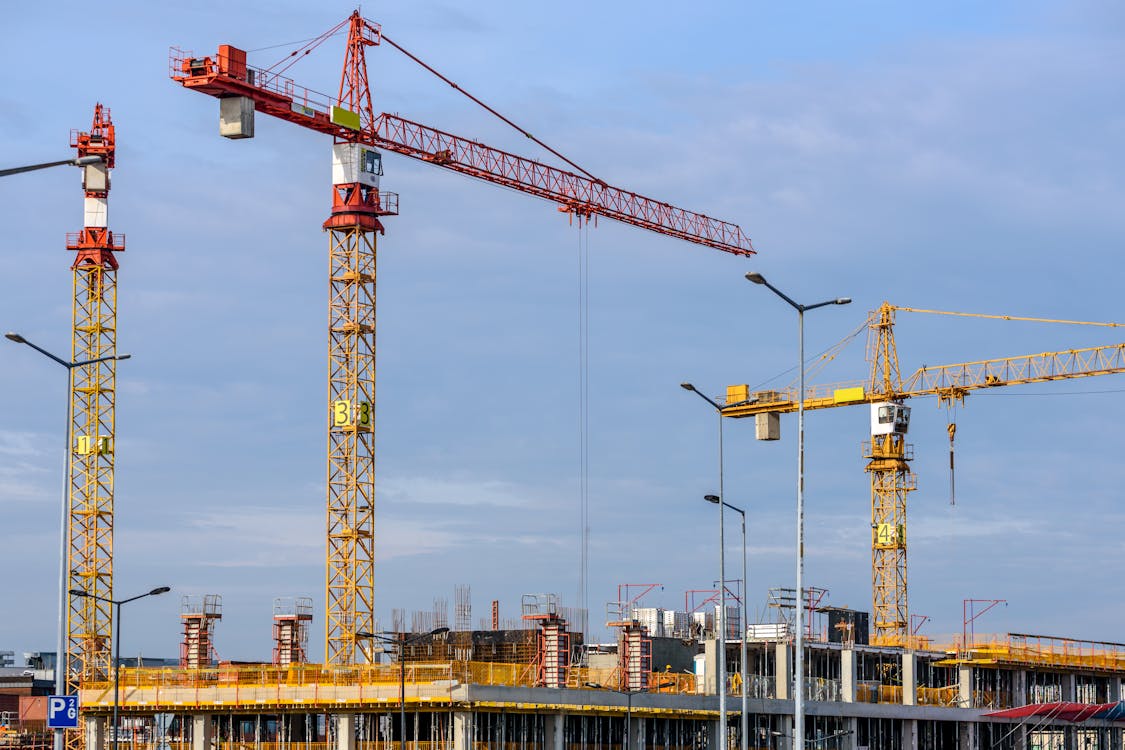What Is Proof Load Testing Of Industrial Equipment?
Date Posted:3 July 2024
Picture a crane hoisting tons of steel or a forklift carrying stacked pallets — now imagine something snaps. The consequences could be dire, both for assets and the workforce. Proof load testing is that extra-strength checkup for your industrial equipment, pushing gear to its limits (in a safe way) to ensure it won't break when it counts.
This controlled test reveals potential weaknesses before they cause disastrous failures, ensuring workers' safety and the operation's reliability. This means fewer accidents, less downtime and a smoother, safer workplace.
Proof load testing defined
Let's get to the heart of it — what is proof load testing for lifting equipment and other industrial workplace gear? Essentially, one can refer to proof load testing as a stress test where a calculated load (heavier than what the equipment normally handles) is applied for a set time. If it withstands the design load without failure or unacceptable deformation, it passes the test.
This differs from a few other types of testing. For example, Working Load Limit (WLL) is the maximum weight a piece of equipment is designed to handle safely during regular use. Think of the WLL as the cargo capacity of a truck — it's the safe amount of weight the truck can haul regularly. Proof load testing goes beyond the WLL to ensure extra strength is built in.
Destructive testing, on the other hand, gets a bit messy. It pushes equipment to the absolute breaking point to figure out its limits. Proof load testing, thankfully, is not designed to destroy anything. In a nutshell, it gives you that extra layer of confidence that your equipment can handle the tough jobs, keeping your workplace safe and productive.
Proof load tests are performed on:
- Below-the-hook devices
- Cranes and hoists
- Chain blocks
- Compression hardware
- Hooks
- Lifts
- Material handling equipment
- Rigging equipment
- Supporting runways
- Suspension equipment
- Telehandlers
- Trolleys

Why is proof load testing important?
Proof load testing isn't just about checking a box — it has real-world benefits for your operations.
Safety
Proof load testing directly translates to a safer workplace. Simulating stresses beyond regular use pinpoints hidden defects like manufacturing flaws, wear and tear or improper modifications. In other words, it's a thorough, pre-emptive equipment inspection that spots the weak links early on. This means potential failures can be caught and corrected before they cause injuries or damage.
Reliability
Across various industrial settings, a single broken part can halt an entire operation. A conveyor belt could snap mid-production and shut down a whole assembly line. A forklift could unexpectedly fail and leave pallets stacked precariously. A crane cable could fray and force a construction project into an unsafe halt.
These breakdowns don't just cause delays — they ripple through your entire operation, leading to lost productivity, costly emergency repairs, expensive replacement parts and even potential penalties for missed deadlines. Proof load testing helps prevent such scenarios by verifying that your equipment is strong enough for the job.
Compliance
Proof load testing goes beyond calculations and blueprints, providing real-world validation during the production process. It verifies whether materials and components perform as intended when integrated within the designed system.
This empirical data confirms that your products meet their specifications and align with the necessary quality and safety standards. By integrating proof load testing into your processes, you gain confidence in your end products and demonstrate a proactive commitment to regulatory compliance.
How is proof load testing performed?
While the specifics vary based on equipment type and testing standards, accredited proof load testers generally follow these key steps:
- Pre-test inspection — A visual and dimensional inspection checks for pre-existing damage and wear and ensures the equipment conforms to specifications.
- Test plan development — Engineers determine the proof load (force above the working load limit), load application method, holding time and acceptance criteria based on standards and equipment design.
- Equipment setup and calibration — The equipment is rigged securely, and load-measuring devices (load cells, dynamometers) are calibrated to ensure accuracy.
- Load application and monitoring — The load is applied gradually, often using hydraulic systems, while technicians monitor the equipment's response and load readings.
- Holding period — The proof load is maintained for the specified time, allowing for potential issues to surface.
- Post-test examination and documentation — The equipment is thoroughly inspected for signs of deformation, damage or unexpected behaviour. Detailed test reports, including pre-test data, test results and certification (if the equipment passes), are then prepared.
Proof load testing of lifting equipment — key takeaways
To restate, proof load testing of lifting equipment is what confirms that it can handle the stresses it's designed for and even a bit more. It's about identifying potential problems before they turn dangerous, protecting your workers and ensuring your operations run smoothly. It’s a proactive investment in safety and efficiency — making it an essential part of your risk management plan.
Verdex — your trusted supplier of tested, reliable material handling equipment
At Verdex, we know safety is paramount. That's why our material handling and storage solutions are designed to pass strict proof load tests, ensuring strength and reliability for various applications. This translates to confidence, minimised downtime and a safer work environment for you and your team. Browse our catalogue today and discover the Verdex difference. Feel free to contact us for more information.




























































































































 Trolleys & Hand Trucks
Trolleys & Hand Trucks Cage Trolleys
Cage Trolleys Cleaning Carts & Trolleys
Cleaning Carts & Trolleys Construction Trolleys
Construction Trolleys Hand Trucks & Dollies
Hand Trucks & Dollies Laundry/Linen Trolleys
Laundry/Linen Trolleys Lifting Trolleys
Lifting Trolleys Order Picking Trolleys
Order Picking Trolleys Panel Cart Trolleys
Panel Cart Trolleys Platform Trolleys
Platform Trolleys Powered Trolleys
Powered Trolleys Shelf & Tiered Trolleys
Shelf & Tiered Trolleys Stainless Steel Trolleys
Stainless Steel Trolleys Tool Trolleys
Tool Trolleys Utility & Service Carts
Utility & Service Carts Lifting & Handling Equipment
Lifting & Handling Equipment Forklift Attachments
Forklift Attachments Jib Attachments
Jib Attachments Lifting Hoists & Pallet Hooks
Lifting Hoists & Pallet Hooks Load Skates & Tow Tugs
Load Skates & Tow Tugs Manual Stackers & Lifters
Manual Stackers & Lifters Pallet Jacks
Pallet Jacks Pallet Lifters
Pallet Lifters Pallet Rotators & Dispenser
Pallet Rotators & Dispenser Powered Pallet Trucks & Electric Lifters
Powered Pallet Trucks & Electric Lifters Scissor Lift Trolleys and Tables
Scissor Lift Trolleys and Tables Conveyor Equipment
Conveyor Equipment Conveyor Frames & Stands
Conveyor Frames & Stands Roller & Skate Conveyors
Roller & Skate Conveyors Ladders & Access Equipment
Ladders & Access Equipment Container & Yard Ramps
Container & Yard Ramps Ladders & Step Stools
Ladders & Step Stools Work Platforms & Crane Cages
Work Platforms & Crane Cages Drum Handling Equipment
Drum Handling Equipment Drum Storage & Bunding
Drum Storage & Bunding Drum Trolleys & Lifters
Drum Trolleys & Lifters Forklift Drum Handling
Forklift Drum Handling Dangerous Goods Storage & Spillage
Dangerous Goods Storage & Spillage Aerosol Cans Storage Cages
Aerosol Cans Storage Cages Bunded Pallets & Storage
Bunded Pallets & Storage Corrosive Goods Storage Cabinets
Corrosive Goods Storage Cabinets DG Storage & Trolleys
DG Storage & Trolleys Flammable Liquid Cabinets
Flammable Liquid Cabinets Forklift Gas Storage Cages
Forklift Gas Storage Cages Site Storage
Site Storage Spill Kits
Spill Kits Waste Handling & Bins
Waste Handling & Bins Bin Lifters & Tippers
Bin Lifters & Tippers Plastic Waste & Wheelie Bins
Plastic Waste & Wheelie Bins Steel Waste & Tipping Bins
Steel Waste & Tipping Bins Waste Carts
Waste Carts Shelving & Storage Equipment
Shelving & Storage Equipment Heavy Duty Cabinets
Heavy Duty Cabinets Heavy Duty Shelving
Heavy Duty Shelving Mega Bins & Pallets
Mega Bins & Pallets Packing & Workbenches
Packing & Workbenches Pallet Racking Accessories
Pallet Racking Accessories Parts Trays & Stor-Pak Bins
Parts Trays & Stor-Pak Bins Pegboard & Louvre Panels
Pegboard & Louvre Panels Plastic Bins & Crates
Plastic Bins & Crates Plastic Handling Solutions Bins
Plastic Handling Solutions Bins Plastic Pallets
Plastic Pallets Stack & Nest Bins
Stack & Nest Bins Stillage & Transport Cages
Stillage & Transport Cages Workplace Equipment
Workplace Equipment Modular Workbenches
Modular Workbenches Electric Height-Adjustable Workbenches
Electric Height-Adjustable Workbenches Floor Matting
Floor Matting General Workplace Equipment
General Workplace Equipment Industrial Weighing Scales
Industrial Weighing Scales Packaging Machinery
Packaging Machinery Stationery Cupboards
Stationery Cupboards Storage and Stillage Cages
Storage and Stillage Cages Tool Trolleys
Tool Trolleys Tooling Cabinets
Tooling Cabinets Safety Barriers, PPE & Signage
Safety Barriers, PPE & Signage Barriers & Bollards
Barriers & Bollards First Aid Equipment
First Aid Equipment Gloves, Knives and PPE
Gloves, Knives and PPE Signage
Signage Cleaning & Site Supplies
Cleaning & Site Supplies Cleaning Equipment
Cleaning Equipment Cleaning Trolleys
Cleaning Trolleys Rubbish Bins
Rubbish Bins Signs & Traffic Supplies
Signs & Traffic Supplies Construction Equipment
Construction Equipment Construction Trolleys
Construction Trolleys Waste Handling
Waste Handling General Site Equipment
General Site Equipment Concrete Equipment
Concrete Equipment Site Storage
Site Storage Lifting Equipment
Lifting Equipment Verdex Specials
Verdex Specials










